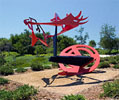
The lessons below are designed for elementary and secondary teachers to prompt classroom discussion and learning centered on sculpture. Lessons include examples of sculpture from the 17th to the 20th centuries in the Getty Museum's collection.
|
 |
|
 |
 |
Lessons 1-6 of 6 |
 |
 |
 |
 |
 |

  |
 |
Capturing the Moment in 3-D
Grades/Level: Upper Elementary (3–5), Middle School (6–8)
Subjects: Visual Arts, History—Social Science
Lesson Overview: Students will examine the sculpture Rearing Horse by Adriaen de Vries. They will then draw and sculpt animals from life, trying to capture motion frozen in a moment.
|
 |
 |
 |
A Design for a Fireplace: Extreme Home Makeover
Grades/Level: Middle School (6–8), High School (9–12)
Subjects: Visual Arts
Lesson Overview: Students will examine a relief sculpture, focusing on its style, function, and design. They will then create a three-dimensional sketch for a decorative overmantel for a patron of their choice as part of an extreme home makeover. This sketch should reflect a current fashionable style.
|
 |
 |
 |
Friendship Portraits
Grades/Level: Upper Elementary (3–5), Middle School (6–8), High School (9–12)
Subjects: Visual Arts
Lesson Overview: Students will examine the bust, Portrait of Nadine Dumas, and create a portrait bust of a friend to give to the friend as a gift. Students will then discuss the modeling techniques used to communicate likeness and expression in a three-dimensional bust portrait.
|
 |
 |
 |
Writing about Art: Objective vs. Subjective
Grades/Level: High School (9–12)
Subjects: Visual Arts, English—Language Arts
Lesson Overview: Students will analyze the sculpture Head with Horns by Paul Gauguin through objective and subjective writing activities and class discussion. They will then consider the meaning of this sculpture and examine the differences between objective and subjective analysis.
|
 |
 |
 |
Flat Shapes in Three Dimensions
Grades/Level: Lower Elementary (K–2), Upper Elementary (3–5), Middle School (6–8), High School (9–12)
Subjects: Visual Arts, History—Social Science
Lesson Overview: Students will analyze the 20th-century sculpture Gandydancer's Dream by Mark di Suvero. They will then use flat shapes and wire to create their own sculpture, which incorporates balance, rhythm, and movement.
|
 |
 |
 |
Sculpting a Message: From the Counter-Reformation to the Present Day
Grades/Level: Middle School (6–8), High School (9–12)
Subjects: Visual Arts, English—Language Arts, History—Social Science
Lesson Overview: Students will learn how images have been used to persuade people in the past and present about a specific message or idea. They will research the 17th-century European Counter-Reformation and discuss how a sculpture of a saint might have been used as a persuasive image in a Catholic convent or monastery. Working in teams, students will then create sculptures commissioned by "patrons" and write press releases to promote their creations.
|
 |
 |
 |
 |
 |
 |
Lessons 1-6 of 6 |
 |
 |
 |
 |
 |

  |
 |





